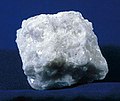Identifying Rocks and Minerals/Types of Rocks
There are three different types of rocks: Igneous, Sedimentary, and Metamorphic. The difference between each type is in how they are formed.
Igneous rocks
[edit | edit source]Igneous rocks have many distinct characteristics. For example, light-colored igneous rocks are more acidic and have over 65% silica. Dark-colored rocks are more basic and have a higher percentage of ferromagnesian minerals. Igneous rocks are broken up into three main groups: acid, intermediate, and basic. Acid rocks have over 65% silica, intermediate rocks have 55-65% silica, and basic rocks have 45-55% silica.
Igneous rock forms when magma (molten rock) cools and solidifies. Extrusive igneous rocks are those formed when magma reaches the surface (at which point it is called lava), cooling and solidifying quickly. Intrusive igneous rocks are formed when magma slowly cools deep below the surface of the earth. Different sized grains form, depending on the conditions of the rock formation. Intrusive rocks are generally more coarse-grained than extrusive. Coarse grains are more than 3/16 of an inch; medium grains, 1/64-3/16; and fine grains, less than 1/64 of an inch. Granite, Rhyolite, Obsidian, Diorite, Felsite, Basalt, and Pumice are all examples of igneous rocks. All these characteristics are key in identifying igneous rocks.
-
Granite
-
Obsidian
Sedimentary rocks
[edit | edit source]Sedimentary rock forms when layers of sand and pebbles are compressed enough to form rock. Fossils are mainly found in sedimentary rock, specifically limestone because limestone is formed in warm, shallow seas where organisms and shells get fossilized at the bottom. There are three different grain sizes in sedimentary rock: coarse, which you can see with the naked eye; medium, which you can see with a hand lens; and fine, which you can see with a microscope.
Sedimentary rocks are split into three different categories: chemical, detrital and biogenic. Chemical refers to rocks containing minerals produced by chemical precipitation. Detrital refers to rocks that contain particles from preexisting rocks. While biogenic rocks contain fossil and shell fragments. Sandstone, Shale, Limestone, and conglomerate are all examples of sedimentary rocks. Igneous and sedimentary rocks are largely prevalent in the world.
-
Sandstone
-
Shale
-
Limestone
Metamorphic rocks
[edit | edit source]Metamorphic rocks form when rocks are subjected to heat and pressure, but not to the point of melting. Depending on whether a rock was formed under just heat or heat and pressure, the orientation of the crystals will be different. Contact metamorphic rocks are formed in just heat, and crystals are randomly arranged.
Regional metamorphic rocks are formed in both heat and pressure and have crystals that are aligned. The greater the pressure and temperature these rocks are exposed to, the larger the grains. Medium to high-grade metamorphic rock formation occurs at a minimum temperature of 480 degrees F and a maximum temperature of 1,472 degrees F, but also at much lower temperatures. Some examples of metamorphic rocks are Slate, Marble, and Granulite. Igneous rocks are formed from cooled magma.
-
Slate
-
Marble






